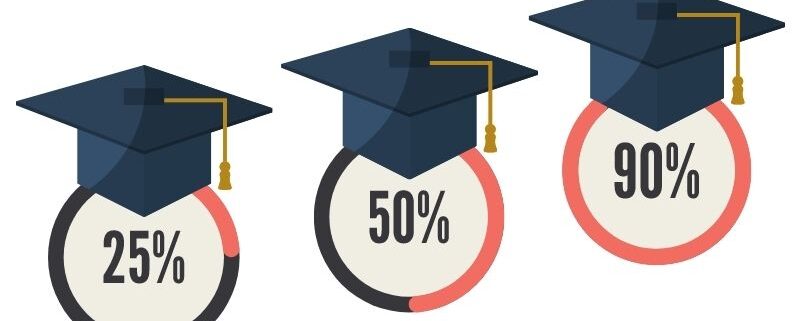Graduation Rate: The 8-Year College Plan?!
Have you given much thoughts to the graduation rate at the colleges your child is considering? Should you? And using what data? Buckle up – there’s a lot here to digest.
Let’s start with this: the US Department of Education defines college graduation rates as “the calculated percentages of students who graduate or complete their program within a specified timeframe.” Colleges share their student data with the Department of Education in order to calculate these rates. Keep in mind that a single graduate rate is published, and at a large university, it represents 100+ majors and thousands of students.
You might be surprised to find out that published graduation rates shared in the US Department of Education’s College Scorecard are 8-year rates. In other words, these rates represent the percentage of students who begin and then complete their bachelor’s degree in 8 years. You will also see other sources publish a 6-year graduation rate.
Do any of us really expect our children to take 6 or 8 years to finish a 4-year program?! Heck no!
Ohio’s school report card publishes college graduation rates for high schools.
You may be very surprised by the statistics. One of our own local high schools, Olentangy Liberty High School, has a college graduation rate of 65.4%. This particular data point reflects the number of students who graduated OLHS in 2013 and went on to graduate from college within six years. (Just as a point of reference, 90% of those that graduated Liberty High School entered college.) Dublin Jerome’s 6-year college graduation rate is 69.8%.
Other Ohio families can search for their own high school’s college graduation rate by clicking here to search and going to the “Prepared for Success” section and the “College Ready” tab.
Those stats may surprise parents, but they are similar to the national averages. The 6-year graduation rate for public colleges nationwide is 57.6%. At private schools, it is 65.4%.
What about a four-year graduation rate? Nationally, it’s a shockingly low 33.3% at public colleges and 52.8% at privates.
Our assumption about graduation rates
Common sense tells us that a higher graduation rate is evidence that a college is doing their job. They are educating their students in a timely fashion. They are providing support and guidance to move each student toward graduation, and they are being transparent by providing data and being held accountable.
But what other factors affect a college’s published graduation rate?
There are factors influencing that rate that are somewhat beyond the control of the college. Non-traditional students like adults who are returning to school are included in the rate. In fact, only 47% of college students are full time, first-year undergraduates fresh from high school. Non-traditional students make up the majority, and they often are taking courses over a longer period of time because they are working adults. Transfer students who have left an institution are also included in the calculation.
A side note about retention rate
According to the College Scorecard, a college’s retention rate is the “share of first-time, full-time undergraduates who returned to the school after their freshman year.” So, that’s how many of the freshman class returned to school the next year. This statistic can be also be good to know when thinking about how well a college will support your child.
Academic readiness
Graduation rates are also a reflection of the type of student accepted by the university. Some colleges accept a larger proportion of students who are less academically prepared than other colleges. Harvard’s graduation rate is 98%. Their accepted students, in general, have very high GPAs and test scores. The graduation rate of Ohio University is 62%, which reflects a more diverse group of learners.
Colleges that have open admission policies (basically all who apply are accepted) tend to have lower graduation rates. They are often community colleges with many non-traditional students and students who transfer to another institution. Columbus State Community College has a graduation rate of only 17%. On the Scorecard detail page, you can see 49% of students withdrew and 33% transferred to another institution.
Financial strain
Money is often a factor in the college’s graduation rate. Families need to know how they are going to pay for college. They need to understand how the college financial system works. (Our free Smart Money Moves for the College-Bound program is a great help.) Students that withdraw from college for financial reasons are often unprepared for the reality of the cost or unexpected expenses come up like when a family member loses a job, or someone becomes ill and has unexpected medical costs.
The decision of where (or if) to go to college has to be made with a full understanding of the costs and their impact on the child’s future budget. What is the student’s estimated future salary? What lifestyle does your child expect to have after graduating? Have what we like to call the “college money talk” so everyone is on the same page. In addition, filling out an estimated future budget worksheet together is a great family project.
Failing to prepare
Besides the academic and financial readiness to go to college, students also need to have those soft skills to be independent adults—discipline, self advocacy, time management, stress management, motivation, enthusiasm, and many more.
These skills are hard to teach, but students and their families need to be honest with themselves about a student’s readiness for college life on their own.
Self-knowledge
As the student prepares for college life, it’s time to be really honest about strengths and struggles. Are students ready for college in all the ways mentioned above? In addition, we’d be remiss if we didn’t mention self-knowledge, especially as related to a college major and future career choices.
Students without a clear picture of their strongest traits, interests, values, challenges, etc. have a hard time visualizing a career that will fit them. Without that knowledge, they run the risk of changing their majors multiple times or even transferring schools. Those types of changes increase the risk of going beyond the 4-year plan.
We encourage students to try “stuff” (lots of it!) early and often. Experiences can include everything from the courses they choose in high school to their extracurricular activities, summer programs, job shadowing, part time work, etc. As they have these experiences, they need to always be evaluating and thinking…was that enjoyable? How did I feel about that experience? What did I learn?
If they have difficulty evaluating those experiences in a way that helps them gain self-knowledge and target a future career, our Guided Self Assessment can help. For years, we’ve been honored to help students think about their experiences and consider how they’ll tie together to work they’ll love. It’s an important step toward having a more confident path for the future.
How can a college’s graduation rate play a part in your college search?
Does Columbus State’s 17% graduation rate mean it is a “bad” school? Not necessarily. It means you have to dig a little bit deeper into the “why” behind that rate. The College Scorecard provides detail in the “Graduation and Retention” section about what happened to the other 83%. Did they withdraw? Did they transfer?
Keeping in mind the accepted students and type of institution, how does a college’s graduation rate compare to other similar colleges? If two colleges with similar types of students have very different graduation rates, then something is going on there that you need to explore further.
If a college’s graduation rate worries you, ask someone in the admissions office about it. They may have specific details to share about why it is low. That school may have programs and initiatives in place to support students with academic or financial problems.
The graduation rate is one factor among many in your college search. Because of factors beyond the control of the university, it shouldn’t be the single, deciding factor.
However, you can use this piece of data especially when comparing similar types of institutions—selective private to selective private or regional state to regional state schools. If you find something that looks odd, that’s when you dig a little deeper. None of us want our child to take 8 years to get that 4-year degree!
Enjoy this post? Don’t want to miss any future blogs about education, college, or careers?











